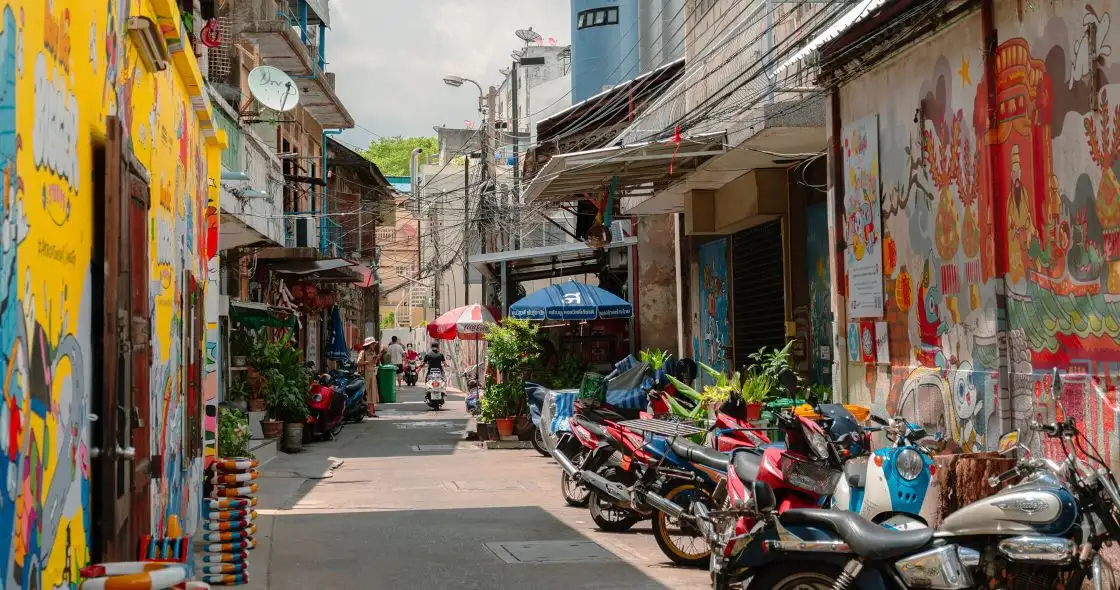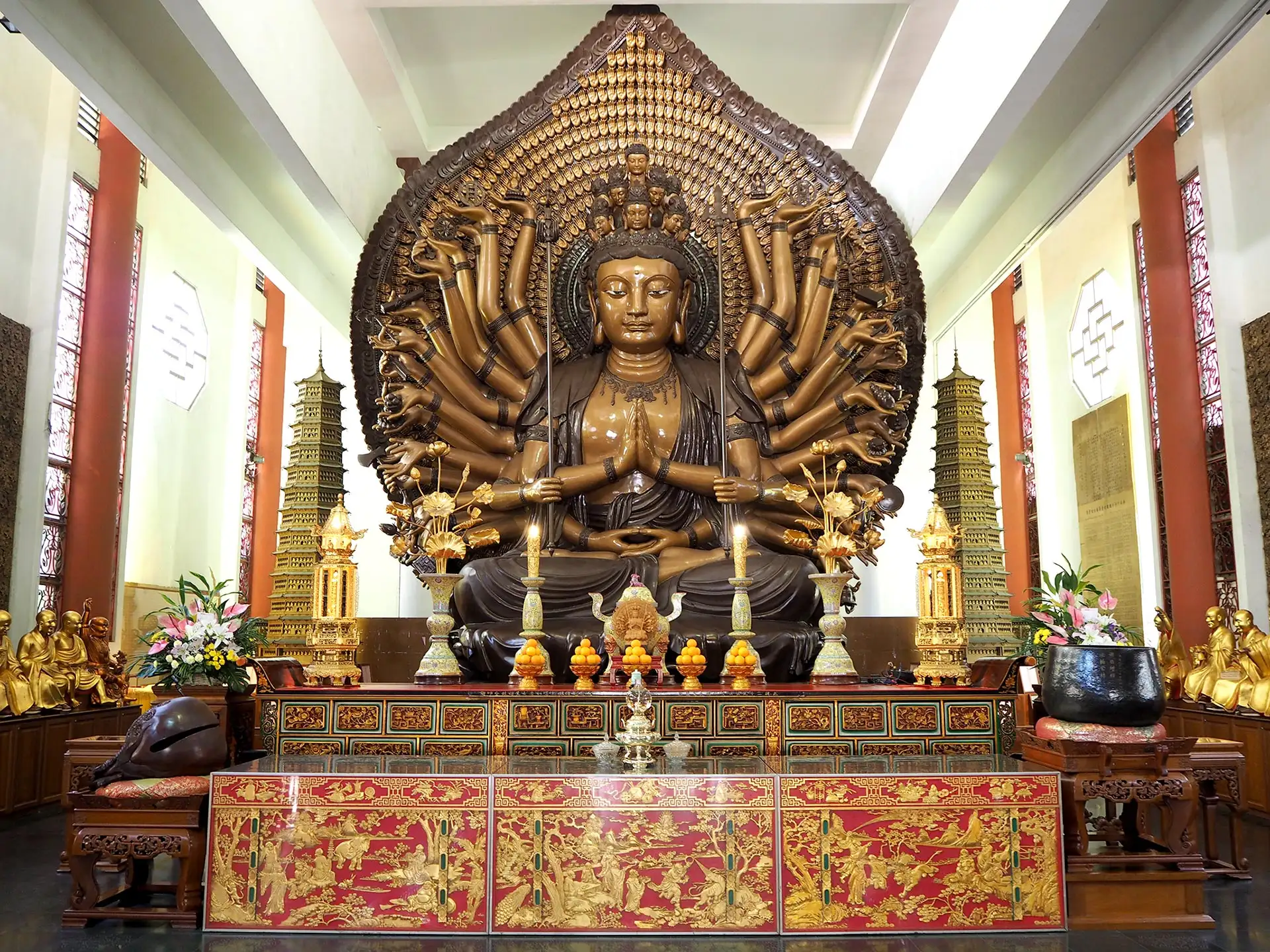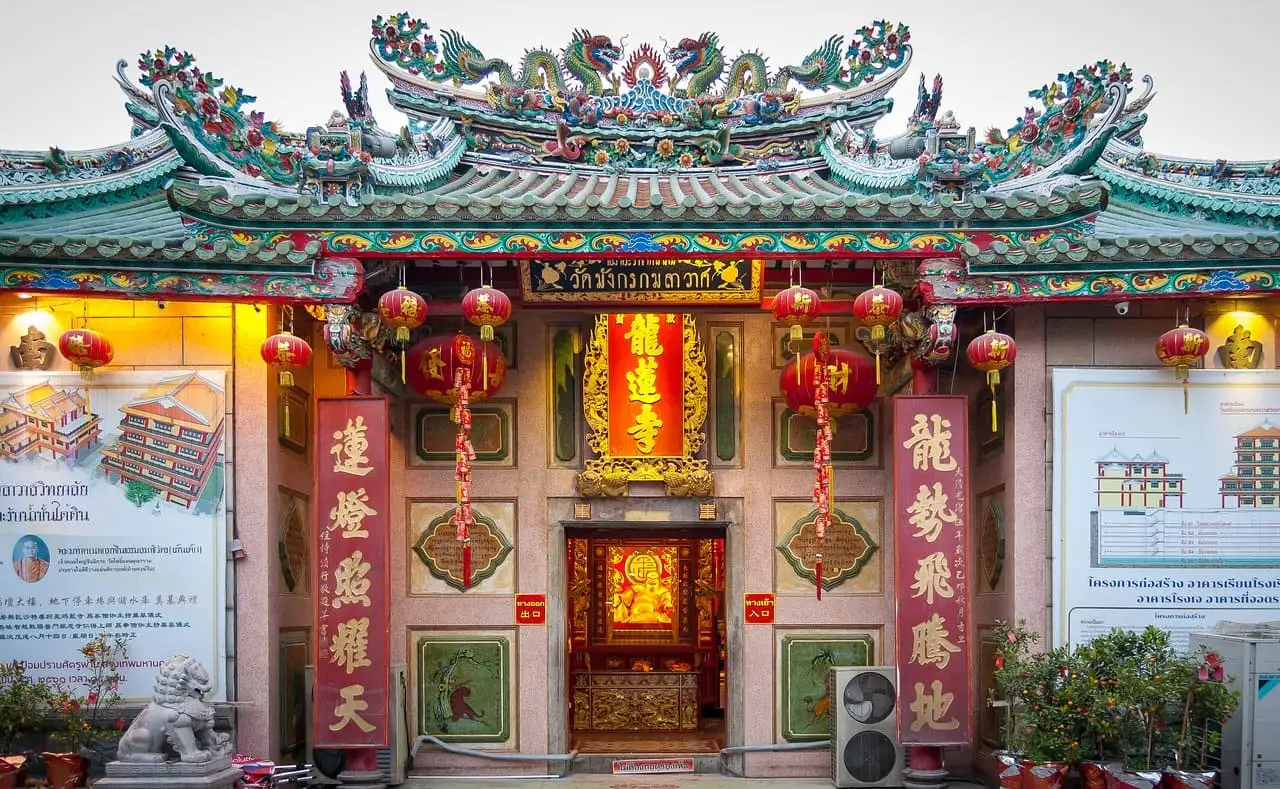Bangkok’s Chinatown, known locally as Yaowarat, is a vibrant, bustling district that offers a sensory explosion of sights, sounds, and flavors. As one of the largest Chinatowns in the world, it blends Thai and Chinese cultures, creating a unique atmosphere filled with historic temples, colorful markets, and some of the best street food in Bangkok. Established in 1782, Yaowarat has grown from a hub for Teochew Chinese immigrants into a must-visit destination for travelers seeking culture, history, and culinary delights.
Top attractions in Chinatown Bangkok
Chinatown is packed with cultural and historical landmarks that reflect its rich heritage. Here are the must-see attractions to include in your itinerary:
Wat Traimit (Temple of the Golden Buddha)
Located near the Chinatown Gate, Wat Traimit is home to the world’s largest solid gold Buddha statue, weighing over 5.5 tons and valued at approximately $250 million. This 13th–14th-century statue, once hidden under stucco to protect it from invaders, is a breathtaking sight. The temple complex also houses the Yaowarat Chinatown Heritage Center, where interactive exhibits and artifacts detail the history of Chinese migration to Thailand.
- Opening hours: 8:00 AM – 5:00 PM
- Entrance fee: 40 THB for the Golden Buddha, 100 THB for the museum
- Tip: Visit in the morning to avoid crowds and enjoy a refreshing breeze from the temple’s open doors.
Wat Mangkon Kamalawat (Dragon Lotus Temple)
As Bangkok’s largest and most significant Chinese-Buddhist temple, Wat Mangkon Kamalawat is a spiritual hub, especially during festivals like Chinese New Year and the Vegetarian Festival. Built in 1872, it features stunning Taoist, Confucian, and Buddhist shrines adorned with intricate carvings and vibrant decorations. The temple’s courtyard is a tranquil oasis amid Chinatown’s chaos.
- Opening hours: 6:00 AM – 6:00 PM
- Entrance fee: Free, donations appreciated
- Tip: Dress modestly (cover shoulders and knees) and visit during festivals for a lively cultural experience.

Sampeng Lane Market
Sampeng Lane is a narrow, bustling alleyway that was once Chinatown’s main commercial street. Today, it’s a shopper’s paradise, offering everything from wholesale clothing and accessories to Chinese handicrafts, electronics, and snacks. The crowded lanes are chaotic but thrilling, with vendors selling budget-friendly goods.
- Opening hours: 8:00 AM – 6:00 PM
- Tip: Bring cash, as most vendors don’t accept cards, and be prepared to bargain for the best deals.
Talad Noi
Just off Yaowarat Road, Talad Noi is a charming neighborhood known for its nostalgic vibe, street art, and historic shophouses. This area, once a trading hub, now attracts photographers and explorers with its colorful murals, vintage car parts shops, and riverside views. Visit the Holy Rosary Church (Kalawar Church), a Gothic-style structure built in 1897 by Portuguese settlers, for a unique contrast to the area’s Buddhist temples.
Tip: Explore on foot or join a guided walking tour to uncover hidden gems and learn about Talad Noi’s history.

Guan Yin Shrine
Located along the Chao Phraya River, the Guan Yin Shrine is one of Thailand’s oldest Chinese shrines, housing a 900-year-old statue of the Goddess of Mercy. Its wooden carvings and golden finishes make it a visually striking stop. Unlike tourist-heavy sites, this shrine offers a serene, authentic experience frequented by locals.
- Opening hours: 7:00 AM – 6:00 PM
- Entrance fee: Free
- Tip: Visit in the early morning to witness local rituals and avoid the midday heat.

Wat Chakrawatrachawat Woramahawihan (Crocodile Temple)
Nicknamed the Crocodile Temple, this 19th-century temple is famous for its resident crocodiles, which live in a pond within the complex. The temple’s serene courtyards and ornate ubosot (ordination hall) provide a peaceful retreat, while the crocodiles add an element of intrigue.
- Opening hours: 8:00 AM – 5:00 PM
- Entrance fee: Free
- Tip: Keep a safe distance from the crocodile pond and visit during the day for the best visibility.
Iconic food and dining in Chinatown Bangkok
Chinatown Bangkok is a foodie’s paradise, renowned for its vibrant street food scene and authentic Thai-Chinese cuisine. Yaowarat Road transforms into one of the world’s largest street food markets at night, with neon-lit stalls serving everything from dim sum to exotic desserts. Here are some must-try dishes and top food spots:
Must-try dishes
- Oyster omelette: A crispy, savory dish made with fresh oysters and eggs, often served with a tangy chili sauce.
- Peking duck: Crispy duck skin wrapped in thin pancakes with hoisin sauce, available at upscale restaurants like Hua Seng Hong.
- Fish ball noodle soup: A light, flavorful broth with chewy noodles and bouncy fish balls, best at Lim Lao Ngow on Songwat Road.
- BBQ pork buns: Steamed buns filled with sweet and savory barbecued pork, a dim sum favorite.
- Durian ice cream: A creamy, pungent dessert for adventurous eaters, available at various stalls.
- Thai curry: Red or green curry served with rice, found at stalls like Mr Talls for a Thai twist in Chinatown.
Top food spots
- T&K Seafood: A legendary spot on Yaowarat Road, T&K Seafood is famous for its fresh grilled seafood, including prawns, crab, and fish. The lively atmosphere and generous portions make it a favorite among locals and tourists.
- Must-try: Stir-fried crab with black pepper, grilled prawns.
- Hours: 4:00 PM – 1:00 AM
- Tip: Arrive early to avoid long queues, and wear casual clothing as it’s a street-side setup.

- Nai Ek Roll Noodle: Operating since 1960, this shophouse serves some of the best pork noodle soup in Bangkok. The peppery broth and tender pork rolls are a perfect late-night meal.
- Must-try: Pork noodle soup with crispy wontons.
- Hours: 7:00 AM – 11:00 PM
- Tip: Order a small portion if you’re sampling multiple stalls.
- Yaowarat Toasted Bread: A sweet treat not to miss, these crispy toasted buns come with fillings like condensed milk, egg custard, or chocolate. They’re a perfect snack while strolling Yaowarat Road.
- Must-try: Egg custard or butter and sugar buns.
- Hours: 6:00 PM – 11:00 PM
- Tip: Share a portion with friends to try multiple flavors.
- Lim Lao Ngow: Located on Songwat Road, this stall is renowned for its fish ball noodle soup, made without flour for an authentic, bouncy texture. The light broth and chewy wontons are a crowd-pleaser.
- Must-try: Fish ball noodle soup with pork wontons.
- Hours: 10:00 AM – 10:00 PM
- Tip: Avoid Mondays, as many stalls, including this one, may be closed.
- Jek Pui Curry: For a Thai-Chinese fusion, Jek Pui Curry serves aromatic, spicy curries with rice or noodles. It’s a great spot for those who prefer Thai flavors over Chinese.
- Must-try: Green curry with pork.
- Hours: 3:00 PM – 9:00 PM
- Tip: Be prepared for a wait, as this small stall is popular with locals.
Food tour recommendation
Navigating Chinatown’s food scene can be overwhelming due to the sheer variety of stalls. Joining a guided street food tour, such as those offered by A Chef’s Tour or Klook, is a fantastic way to sample the best dishes while learning about the area’s culinary history. These tours typically cover 10–20 dishes, including hidden gems like crispy chive dumplings and slow-braised pork, and are led by knowledgeable local guides.
Tips for an unforgettable visit
To make the most of your Chinatown Bangkok experience, keep these practical tips in mind:
- Best time to visit:
- Daytime: Ideal for temple visits and markets, as many temples close by sunset. Mornings are cooler and less crowded.
- Evening: Yaowarat Road comes alive after 6:00 PM with street food stalls and neon lights. Avoid Mondays, as many food vendors are closed.
- Festivals: Visit during Chinese New Year (January or February) or the Vegetarian Festival (September or October) for vibrant celebrations and special dishes.
- Getting there:
- MRT: Take the Blue Line to Wat Mangkon Station, a 5-minute walk from Yaowarat Road.
- Ferry: Hop on a Chao Phraya River ferry to Ratchawong Pier for a scenic approach.
- Tuk-Tuk/Taxi: Use ride-hailing apps like Grab for convenience, but expect traffic in the evening.
- Walking: If staying near the Grand Palace or Hua Lamphong Station, Chinatown is within walking distance.
- What to bring:
- Cash: Most street vendors don’t accept cards, so carry small denominations of Thai Baht.
- Comfortable shoes: You’ll be walking through crowded alleys and markets, so wear sturdy footwear.
- Light clothing: Bangkok’s heat and humidity can be intense, especially in narrow lanes.
- Water bottle: Stay hydrated while exploring, as the heat and spicy food can be taxing.
- Safety and etiquette:
- Stay aware: Pickpocketing is rare but possible in crowded areas. Keep valuables secure and avoid flashing expensive items.
- Respect temples: Dress modestly (cover shoulders and knees) and remove shoes when entering temple halls.
- Be adventurous but cautious: Try new foods, but check stall hygiene (look for busy stalls with fresh ingredients). If you’re unsure, opt for a guided food tour.
- Photography tips:
- Yaowarat Road’s neon signs and bustling crowds make for stunning photos, especially at night.
- Capture the intricate details of temples like Wat Traimit and Wat Mangkon Kamalawat during the day for better lighting.
- Ask permission before photographing vendors or locals to show respect.
- Where to stay:
- Hostel urby: A budget-friendly option with a rooftop bar and modern amenities, perfect for travelers wanting to stay in the heart of Chinatown.
- ASAI Bangkok Chinatown: A stylish, affordable hotel with easy access to Yaowarat Road.
- Shanghai Mansion Bangkok: A boutique hotel with Sino-Thai decor, offering a luxurious stay steeped in Chinatown’s heritage.
Why visit Chinatown Bangkok?
Chinatown Bangkok is more than just a neighborhood—it’s a cultural and culinary journey that captures the essence of Thai-Chinese heritage. Whether you’re marveling at the Golden Buddha, weaving through the chaotic Sampeng Lane Market, or savoring a bowl of fish ball noodle soup, every moment in Yaowarat is an adventure. The district’s ability to blend ancient traditions with modern vibrancy makes it a standout destination in Bangkok.
For first-time visitors, the sensory overload of neon lights, sizzling woks, and crowded alleys can be daunting, but with this guide, you’re equipped to navigate Chinatown like a pro. Embrace the chaos, follow your nose to the best food stalls, and immerse yourself in the rich history and culture. Chinatown Bangkok promises an unforgettable experience that will leave you hungry for more.
Plan to spend at least half a day exploring Chinatown Bangkok to fully appreciate its attractions and flavors. Whether you’re a history buff, a foodie, or a photographer, Yaowarat has something for everyone. From the awe-inspiring temples to the mouthwatering street food, this vibrant district is a highlight of any Bangkok itinerary. So, pack your sense of adventure, bring an empty stomach, and dive into the heart of Chinatown Bangkok for a trip you’ll never forget!

